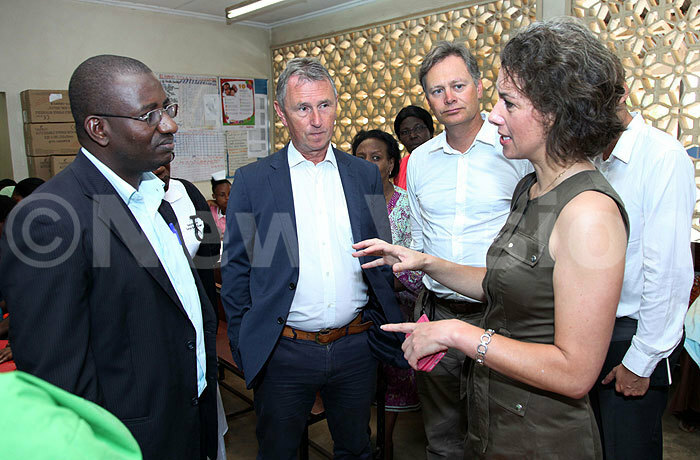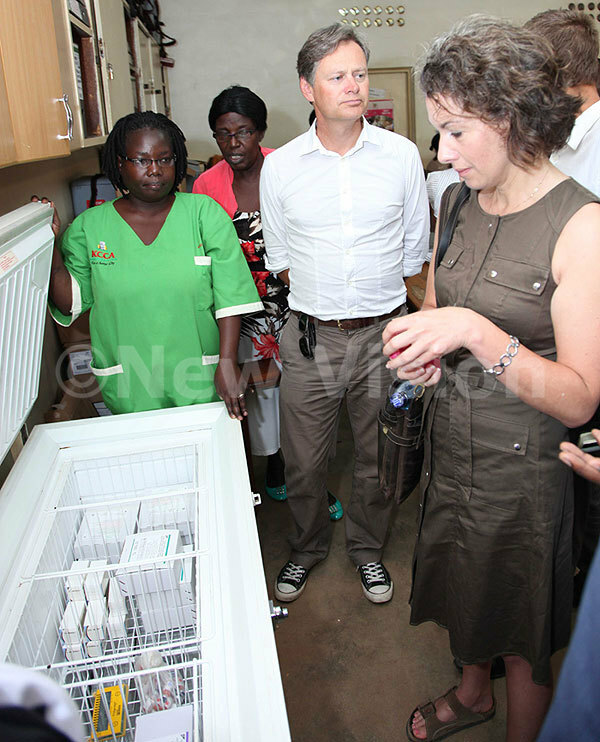British MPs inspect health centres to evaluate GAVI projects
The officials made their first inspection at Kiswa Health Centre III in Nakawa.
PIC: UK MP Sarah Champion (R) talks to Village Health Team member Annet Obore (L) and Senior Nursing Officer Irene Nabukwasi (2nd-L) while other visiting British MPs Nigel Evans and Matthew Offord look on during an inspection of Kiswa Health Centre IV on Tuesday. (Credit: Hajarah Nalwadda)
KAMPALA - A team of British legislators are in Uganda to assess the immunization programme in various health centres, a programme largely funded by Global Vaccine Alliance (GAVI).
The team, accompanied by another three personnel from UK's health advocacy group, is to ascertain whether or not their tax payers' money is put to good use.
The British Government, through its department for International Development (DFID), contributes significant amount to approximately $100m (about sh333bn), for which Uganda benefits from GAVI every two years to immunize her 1.5 million infants annually.
The officials who arrived in the country on Sunday made their first inspection at Kiswa Health Centre III in Nakawa, Kampala.
They will pay impromptu visits to other public facilities that offer immunization, from the outright lower level health centre III's to the higher level regional referrals.

The visiting MPs are seen here talking with Nakawa Division's medical officer Christopher oundo (left) at Kiswa Health Centre IV. (Credit: Hajarah Nalwadda)
Sarah Champion, a UK parliamentarian, said: "Today [Tuesday], we visited an urban setting facility (Kiswa). After here, we have an appointment with the Ugandan Parliament Speaker Rebecca Kadaga. Tomorrow, we shall go to the rural settings facilities."
Jim Calverley, a UK child health parliamentary advocacy officer, said: "Donors contribute a lot of money to improve the quality of life and healthcare in developing countries. This money needs to be put to good use and to programmes it is intended for."
At Kiswa, they inspected, among others, the waiting room for expectant mothers waiting for their appointment with a midwife and mothers who had brought their children for vaccination.
They also took photos of wall hospital placards using their cameras and inspected the storage facility for the vaccines and examined the facility vaccine register, and how the facility ensured babies complete the immunization programme.
A senior nursing officer Irene Nabukwasi said they have Village Health Teams (VHTs) that help them to mobilize mothers to take to the facility their babies for immunization.
The nurse also informed the visiting lawmakers that they do not have enough vehicles to sufficiently transport vaccines, saying they at times have to use motorcycles.
It was also revealed that the facility only has two midwives, who catered for over 1000 babies immunized in a month.

Dr. Christopher Oundo, the Nakawa division medical officer, said they had a 50% shortage of tetanus vaccines after government included the jab in a list of compulsory essential commodities for safe male circumcision (SMC).
He said over 4500 girls (out of 10,000) between 10 and 14 years in Nakawa division, who need a human papillomavirus vaccine to prevent them against cervical cancer, have not received it yet because the vaccines ran out.
Even some of the 5500 girls who got the initial vaccine are waiting for a second dosage.
The national vaccination coverage is estimated at 80%, meaning 20% of Ugandan children are not immunized against the nine killer (but immunizable) diseases.
Government of Uganda contributes 20 cents towards immunization of each child. This is about $3m. But GAVI figures indicate almost 20 dollars is needed to vaccinate one child.